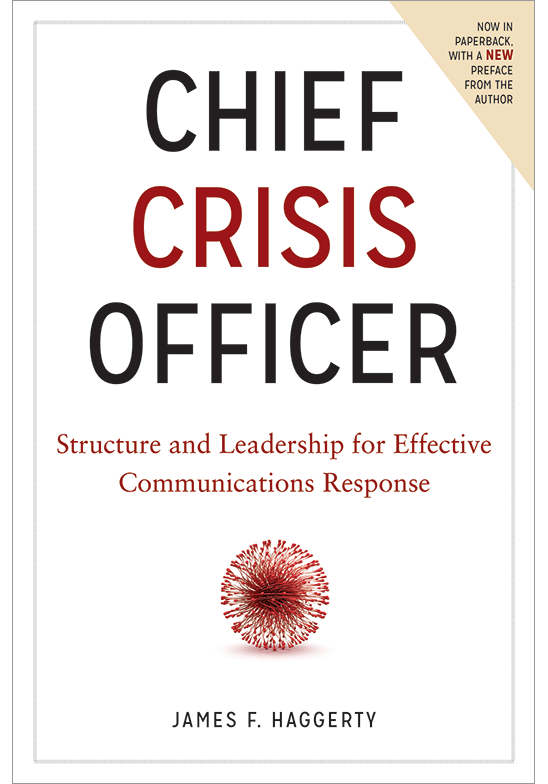‘Chief Crisis Officer’: Formulating Template Messages in the Crisis Plan

This is an excerpt from CrisisResponsePro founder James F. Haggerty’s new book, Chief Crisis Officer: Structure and Leadership for Effective Communications Response (ABA Publishing). We will post other excerpts to the Knowledge Exchange periodically. In this section, Haggerty discusses messaging in templates.
In communicating about a crisis, you must ensure you are creating messages that resonate with the proper public audiences in a manner that doesn’t allow your crisis to spin out of control. But can you realistically anticipate every possible crisis scenario that might possibly face your company, and create template messages beforehand to respond?
Of course not. You cannot anticipate everything, but you don’t have to. You only have to prepare scenarios for the most common crises your organization might face. It’s really not that hard either — 10, 20, 30, or whatever the number might be for your particular size, industry, and risk profile. If you’re Walmart, you might have more; a small mom-and-pop retailer with less than a dozen locations will have less.
My point is that the Chief Crisis Officer and his or her team should have thought long and hard about these crisis scenarios and the messages that would work under a variety of circumstances well before the accident occurs, the data breach is discovered, or The New York Times investigative reporter calls.
Moreover, if your crisis plan is a “living document,” you are constantly updating your templates for various crisis scenarios based on what works and what doesn’t, as well as new potential crises that weren’t on your radar when the crisis plan was first created.
I know there are skeptics out there: “Sorry, no, there’s no way. Our business is just too big, too complex, the issues we face too often sui generis. It wouldn’t work for us.”
Respectfully, you are wrong. Just as BP could have anticipated an oil leak in the Gulf of Mexico, Target a credit card data breach, and Volkswagen rigged test data given to regulators, your organization’s crisis communications team can sit down and anticipate the top crisis scenarios that might confront your company.
After all, Walmart, for example, surely could have anticipated potential FCPA investigations and media interest. They operate in 28 countries on five continents: Issues involving potential bribery in one of those countries is clearly within Walmart’s risk profile.
Technology Role
Technology can play a role here as well. Effective crisis communications software, which can bring the crisis team together virtually and provide tools and a collaborative platform for effective crisis response, can host a range of templates, talking points, employee emails, and other messages. The point is: A basic template that contains sample language and messaging serves as a starting point for the crisis communications team and will lead to the creation of better public messages (even if, in many cases, the final statement issued barely resembles the initial template).
Here is sample media “holding” statement:
Statement of [Hospital Spokesperson]
[Title]
DATE — [Optional Paragraph: Express sympathy, if appropriate, for loss.]
[Paragraph 1: A short factual statement of what has happened — as much information as is known. Do not speculate, and remind media that you are still collecting relevant information.]
[Paragraph 2: Explain as much as is known about what will happen next, e.g. “As we learn more, we will immediately . . .”]
[Paragraph 3: Reiterate ABC Hospital’s commitment to the community and to safety/security/best practices.]
###
This is a basic “core” message that we will use to communicate to various audiences about this particular crisis, containing the necessary information, using a heartfelt tone, and short on legalese or jargon. The statement following this, the template for which should also be prepared, will be more detailed.
These messages can be adapted as talking points for those communicating via telephone or in person to key stakeholders; messages (emails) to employees, customers, or others; and initial tweets.
The immediacy of crisis communications response means we don’t have much time to compose messages after the crisis has begun. If you already have detailed templates, you are more prepared to deliver messages during a crisis that — while perhaps not Churchillian in their effect — fulfill their mission to help stop the crisis from spinning out of control.
This is an abridged version of an article that appeared today on the CrisisResponsePro paid subscription portal. (CrisisResponsePro subscribers can access the full version by clicking here. ID and password are required.) To take advantage of all of the content, data, and collaborative resources CrisisResponsePro has to offer, contact us at info@crisisresponsepro.com.




 Back to Blog
Back to Blog